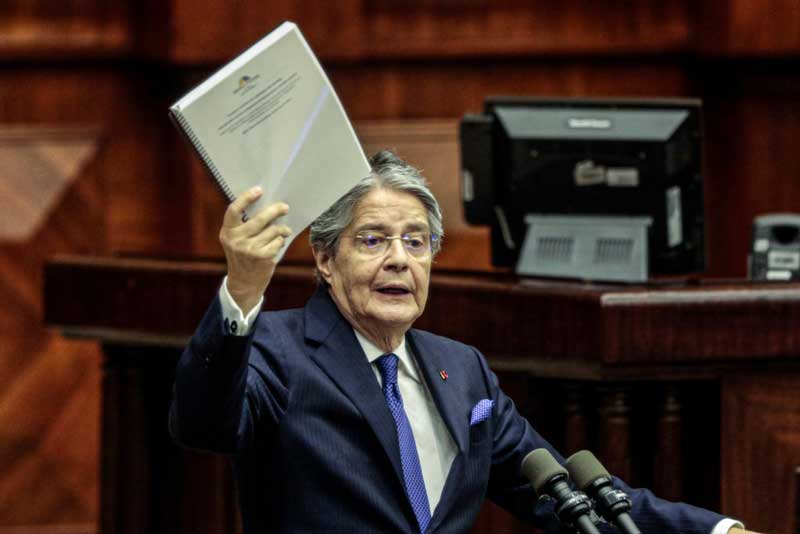The grand vision and ambitious plans that President Guillermo Lasso had encountered two formidable obstacles in Ecuador’s political landscape: the National Assembly and the Constitutional Court. Throughout his tenure, the Executive’s management faced a series of setbacks, raising doubts about the government’s ability to implement its agenda effectively.
One of the most significant blows to President Guillermo Lasso’s administration came from the Constitutional Court on August 1st. The Court approved precautionary measures against Executive Decree No. 754, issued on May 31, 2023. This decree was intended to put limitations on environmental consultations, a constitutional requirement for extractivist projects. The suspension of this regulation has now left around 100 public and private works in limbo, creating uncertainty and frustration among stakeholders.
But this is merely a glimpse of the challenges posed by the Constitutional Court, which often caught the Government off guard in a political landscape where it thought it could govern unimpeded after the dissolution of the National Assembly.
During the Correísmo era, Ecuador was accustomed to a Constitutional Court that did not oppose the Executive, avoided ex officio controls on presidential actions, and rarely ruled against it.
However, the dynamics shifted in 2019 when the Transition Council for Citizen Participation appointed new judges to the Court, turning it into an active player in the country’s political arena. These newly appointed judges began to voice their opinions and issue controversial verdicts that challenged the Executive’s authority.
Former Court President Hernán Salgado is among the critics who questioned the Court’s recent actions, arguing that the judges were overstepping their roles by analyzing the urgency of President Lasso’s proposed projects. The unexpected assertiveness of the Constitutional Court has had a considerable impact on the President’s legislative plans, particularly those aimed at bypassing the dissolved National Assembly using decree laws in urgent economic matters.
Notably, 75% of the decree laws proposed by President Lasso have been rejected. Measures related to free zones, educational loans, and bankruptcy failed the Court’s constitutional scrutiny, leaving only the tax reform approved. This unfavorable track record foreshadows a challenging road ahead for the other projects that President Lasso envisioned to implement through decree laws, given the Court’s formidable counterweight against the Executive.
Even after dissolution of the Assembly, the President’s major legislative ambitions continue to remain unfulfilled. Whether in the form of bills, decrees, or decree laws, the lack of a functioning legislature has forced the President to navigate the treacherous waters of the Constitutional Court.
One glaring example of this is the issue of states of exception. During Rafael Correa’s presidency, the Court rarely challenged the 91 states of exception he declared. In contrast, the Court, post-2019, became strict and critical of those declared by Lenín Moreno, particularly during the pandemic. Now, the Court’s scrutiny extends to President Lasso’s states of exception as well, with several of his decrees facing modifications or being declared unconstitutional by the judges.
Hit from both sides
The relationship between President Lasso and the National Assembly was complex from the outset, reaching its boiling point in May when the President chose to dissolve the Assembly, intending to govern solely until the results of the extraordinary elections in August were finalized.
Without a strong majority or a legislative bloc and having lost key political support, President Lasso found his administration’s possibilities limited from the start. Moreover, accusations directed at opposition figures from Carondelet, the presidential palace, further strained the President’s relationship with the Assembly, hindering the acceptance of his proposals.
During his tenure, President Lasso sent nine bills to the dissolved Assembly. Three were archived, two remained pending, and four went through the legislative process.
However, of these four, only one made it into the Official Register in its proposed form, as it entered through the Ministry of Law without any modifications from the legislators. The other three bills underwent significant changes, particularly the security project.
Even the presidential vetoes, often utilized to introduce legal contributions, did not find a favorable reception. The Assembly consistently held enough votes to uphold its original proposals, further undermining President Lasso’s efforts to advance his agenda.
As Lasso comes into his final month before a new president in elected, his government continues to face formidable challenges in navigating the political landscape of Ecuador. Both the Constitutional Court and the National Assembly proved to be significant obstacles in implementing the President’s vision for the country.
The future of Lasso’s agenda and his legacy remains uncertain, raising questions about the any future government’s ability to deliver on its promises and tackle pressing national issues.



0 Comments